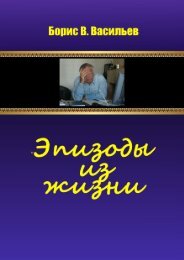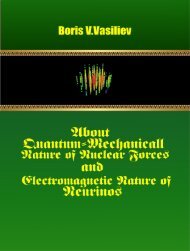978-1-940366-36-4_WholeBook
Boris V. Vasiliev Supercondustivity Superfluidity
Boris V. Vasiliev
Supercondustivity Superfluidity
You also want an ePaper? Increase the reach of your titles
YUMPU automatically turns print PDFs into web optimized ePapers that Google loves.
Chapter 4 Basic Milestones in the Study of Superconductivity<br />
superconductors depend on the isotope mass Mi, from which they are made:<br />
T c ∼ 1<br />
M i<br />
a . (4.40)<br />
This dependence was called the isotope effect. It was found that for type-I<br />
superconductors - Zn, Sn, In, Hg, P b - the value of the isotope effect can be described<br />
by Eq.(4.40) at the constant a = 1 2 .<br />
0.622<br />
log T c<br />
0.621<br />
0.620<br />
0.619<br />
198 199.7<br />
200.6<br />
0.<strong>36</strong><br />
0.618<br />
202<br />
0.617<br />
203.4<br />
0.616<br />
0.615<br />
0.5<br />
log M<br />
2.296 2.298 2.300 2.302 2.304 2.306 2.308 2.310<br />
Figure 4.3 The isotope effect in mercury. The solid line is obtained by the<br />
sparse-squares technique. In accordance with the phonon mechanism, the coefficient a<br />
must be about 1/2 (the dotted line). As it can be seen, this coefficient is in reality<br />
approximately equal to 1/3.<br />
This effect has made researchers think that the phenomenon of superconductivity is<br />
actually associated with the vibrations of ions in the lattice. This is because of the similar<br />
dependence (Eq.(4.40)) on the ion mass in order for the maximum energy of phonons to<br />
exist whilst propagating in the lattice.<br />
Subsequently this simple picture was broken: the isotope effect was measured for<br />
other metals, and it had different values. This difference of the isotope effect in different<br />
superconductors could not be explained by phonon mechanism.<br />
Science Publishing Group 41













